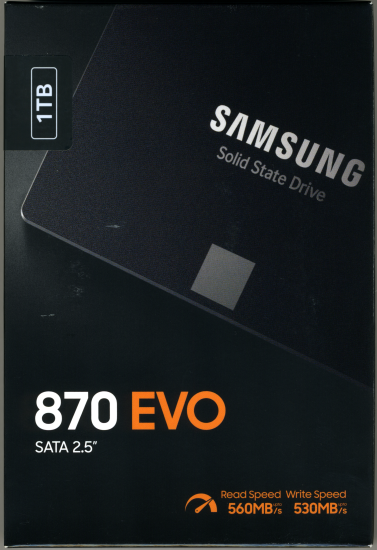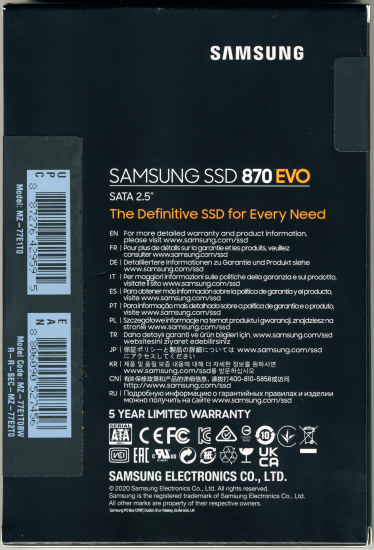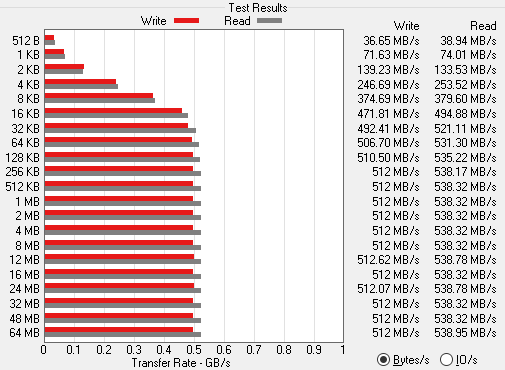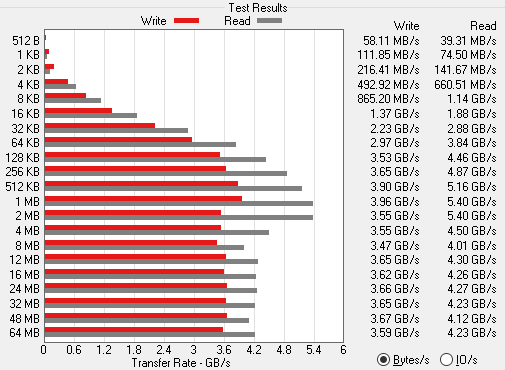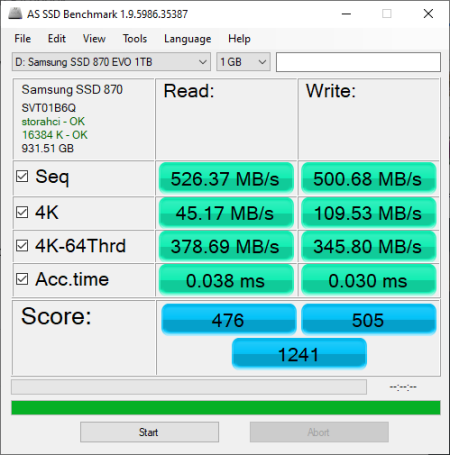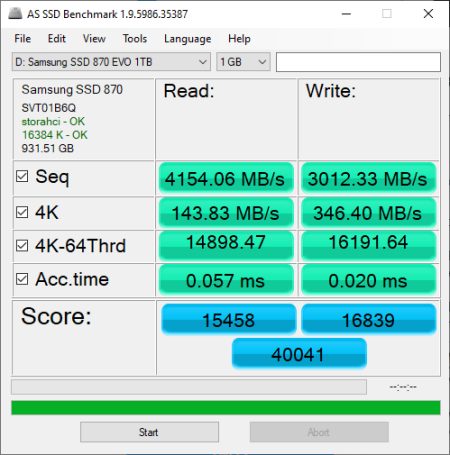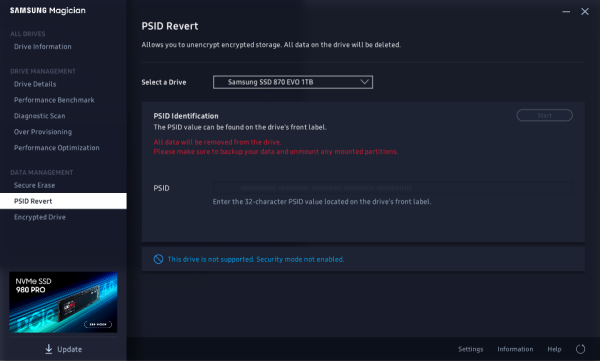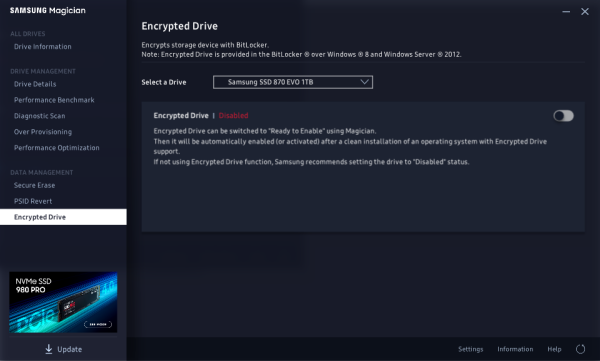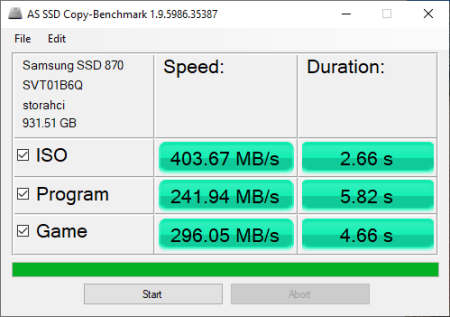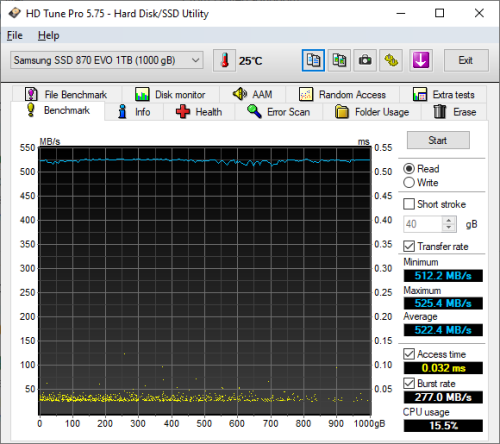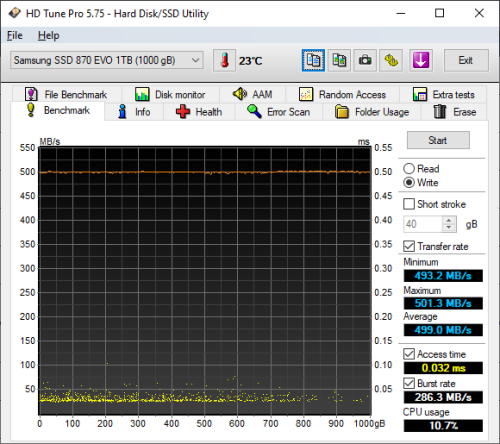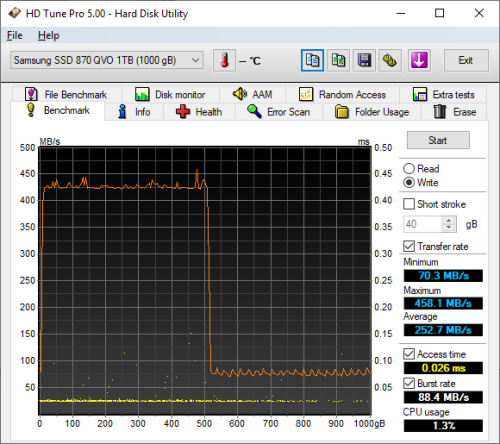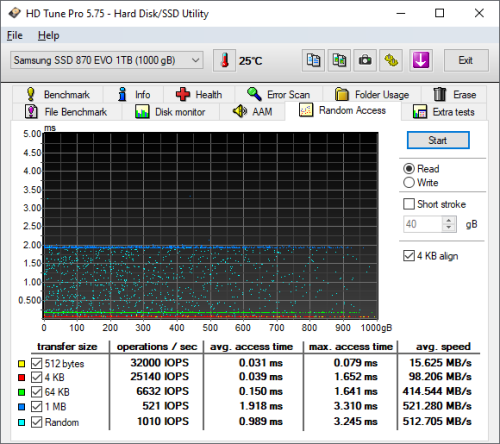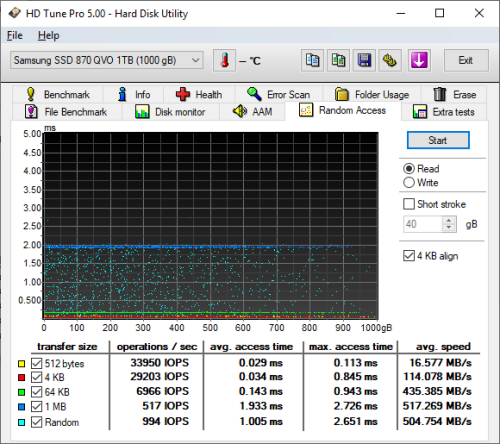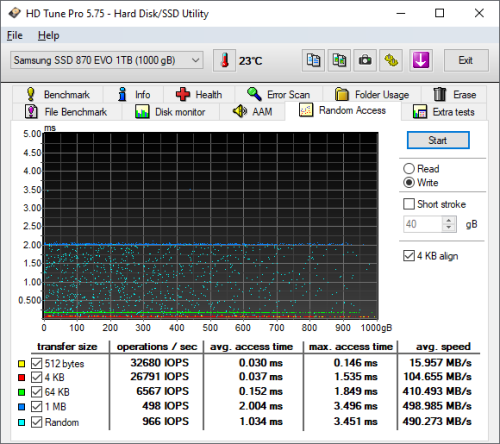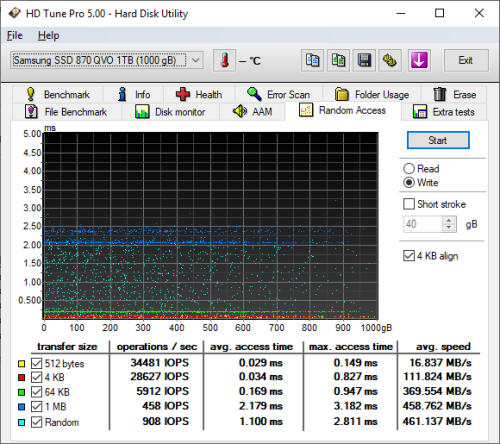
![]()
Model: Samsung 870 EVO 1TB Solid State Drive
Manufacturer: Samsung Electronics
Provided By: Samsung America
Samsung Electronics has been a leader in the electronics industry for more than 30 years. Since the introduction of their first television in 1970, this Korean company has grown to become one of the world's leading electronics manufacturers, offering everything from tiny semiconductors to large home appliances. Samsung is no stranger to the storage industry either. Along with an assortment of DVD and Blu-ray Disc drives, the company offers both hard drive and flash based storage solutions for the portable and desktop computer markets.
Samsung recently introduced its latest 2.5-inch SATA SSD, the 870 EVO. Delivering a compelling mix of performance, reliability and compatibility for casual PC and NAS users, this new drive is powered by Samsung's MKX "Metis" controller and is available with up to 4TB of their latest 3-bit MLC V-NAND flash. This combination not only allows the 870 EVO to reach sequential read and write speeds of 560 and 530 MB/s, respectively, it delivers a 30% improvement in sustained performance as well as a 38% improvement in random read speed over its predecessor, the 860 EVO. The drive also offers a long list of features including Samsung's Intelligent TurboWrite technology, AES 256-bit hardware-based encryption and support for the company's Magician software.
The 870 EVO is available in 250GB, 500GB, 1TB, 2TB and 4TB capacities. For this review, Samsung sent us the 1TB version of the drive, which is capable of delivering up to 560 MB/s sequential read and 530 MB/s sequential write speeds as well as up to 98,000 random read and 88,000 random write IOPS.

Needless to say, this is only a taste of what the 870 EVO has to offer. To give you an idea of what to expect, we'll take a closer look at Samsung's new SATA SSD and then see how well it performs. Does the 870 EVO have what it takes? Can it deliver the performance and features that we've come to expect from Samsung? Keep reading as we find out.
The 870 EVO comes in a small black box. Along with a picture of the drive, the packaging advertises a number of its key features including its 1TB capacity, rated read and write speeds, and 5 year warranty. Inside, you'll find the SSD as well as a small installation guide and warranty statement.
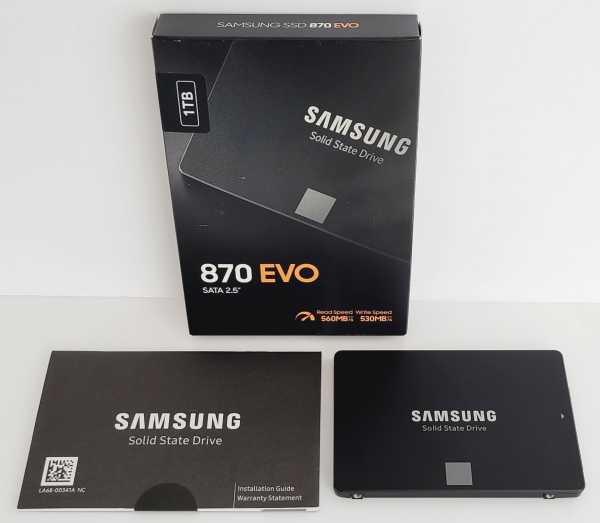
Physical Features:
Like Samsung's other 2.5-inch SSDs, the 870 EVO is very well constructed. The drive's outer casing is made entirely out of aluminum and is very strong and lightweight. The 870 EVO also shares the same black and gray color scheme found on the 860 EVO. In fact, the only real way to tell the two drives apart is to flip them over and look at the label on the bottom.

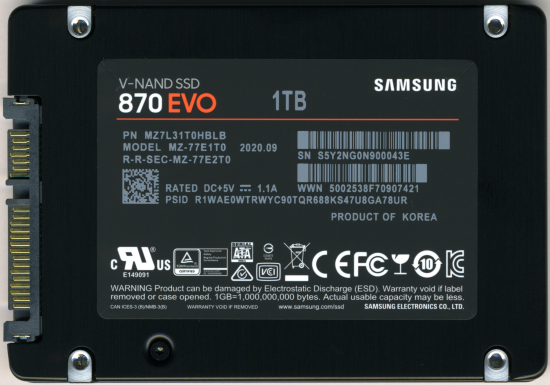
Like the 870 QVO, the 870 EVO uses Samsung's MKX "Metis" controller. Aside from the fact that it was designed and produced in-house, very little is known about this controller at this time.
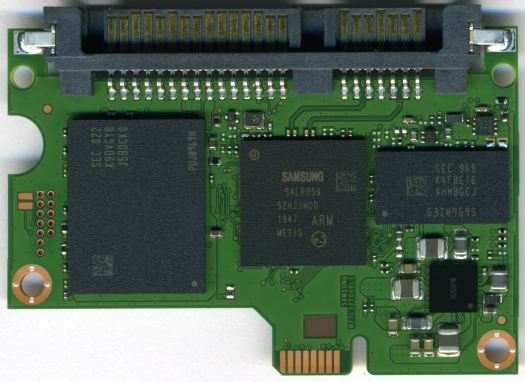
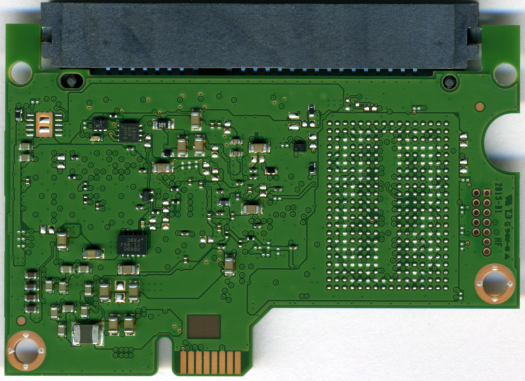
For the 1TB version of the 870 EVO, Samsung used their own 3-bit MLC V-NAND flash chips. Looking at the pictures above, you can see that there is a single 1TB NAND flash package on the top of the PCB. The drive also has a single 1GB LPDDR4 DRAM memory chip that is used for caching.
The Samsung Magician software is designed to help users easily monitor the health and maximize the performance of their Samsung SSD. From the main screen, users can check the condition of their drives and view information like the temperature, total and available capacities and the total bytes written.
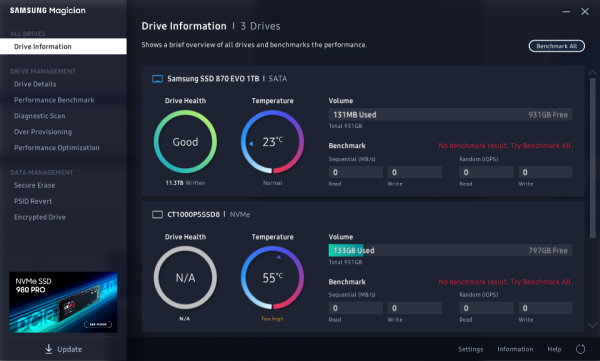
Magician also provides detailed information about each drive. In addition to the drive health and temperature, this screen shows the serial number, interface speed, firmware version and whether or not AHCI mode is activated. You can even see which volumes are on the drive and how much of the total capacity they are using.
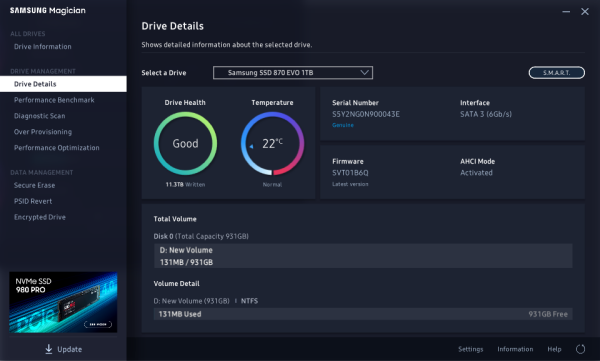
Samsung's Magician software can also be used to benchmark the performance of a storage device. Looking at the screenshot below, you can see that it tests the sequential and random read and write performance of a drive. Users can also compare these scores with past results to maintain the highest performance possible.

Using Magician, users can also do a diagnostic scan to find and fix any errors and optimize the performance and lifespan of their SSD by setting aside extra free space.
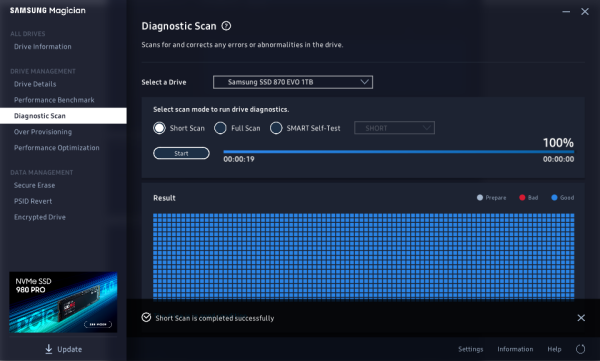
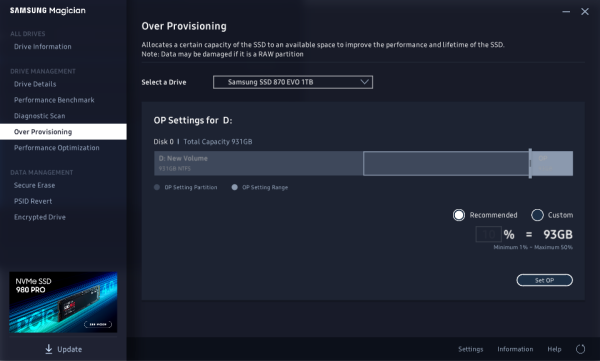
Magician also gives users the ability to improve the performance of their drive by forcing TRIM to run. In addition to this, users can enable RAPID (Real-time Accelerated Processing of I/O Data) mode to accelerate their drive's performance through DRAM caching.

When enabled, RAPID mode is inserted as a filter driver in the Windows storage stack. The driver actively monitors all storage-related activity between and among the operating system, user applications and the SSD. The RAPID technology analyzes system traffic and leverages spare system resources (DRAM and CPU) to deliver read acceleration through intelligent caching of hot data and write optimization through tight coordination with the SSD.

Samsung 870 EVO 1TB with RAPID
Samsung's Magician software also includes a number of data management features. Along with the ability to permanently delete sensitive data, it can unlock and reset your drive to its factory setting by entering the 32-character PSID password printed on the drive label. Last, but not least, Magician gives you the ability to activate Encrypted Drive to protect private and sensitive data. The software lets you review your drive’s current security settings and helps you with the setup process.
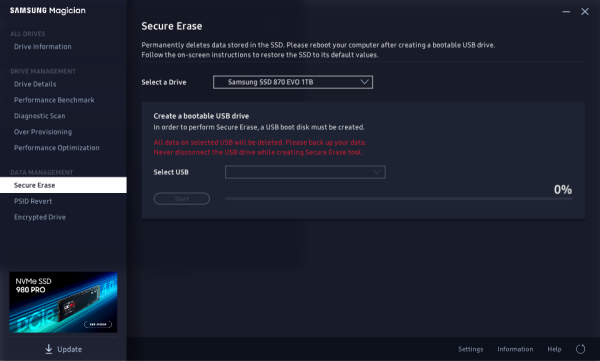
The test system used in this review is equipped with an AMD Ryzen 3 3100 CPU, MSI B550 GAMING PLUS motherboard, 16GB (8GB x 2) of Crucial Ballistix 3200 MHz DDR4 memory, Crucial P5 1TB SSD and a GIGABYTE GeForce GTX 1060 WINDFORCE OC 6G graphics card. For the operating system, I used the latest version of Windows 10 Pro.
To test the performance of Samsung's 870 EVO SSD, I ran a series of benchmarks using CrystalDiskMark, HD Tach RW, ATTO Disk Benchmark, AS SSD, HD Tune Pro, Anvil's Storage Utilities, Iometer and PCMark 8. For comparison, I've also included test results from the Samsung 870 QVO, SK hynix Gold S31, ADATA Ultimate SU750, Samsung 860 QVO, Samsung 860 PRO, Crucial MX500, Plextor M8V, Crucial BX300, ADATA Ultimate SU900, Plextor S3C, Toshiba OCZ VX500, ADATA Ultimate SU800, Plextor S2C, Crucial MX300, Plextor M7V, PNY CS1311, OCZ Trion 150, PNY CS2211, Plextor M6V, Crucial BX200, OCZ Trion 100, Kingston HyperX Savage, Crucial MX200, OCZ Vector 180, Kingston BX100, Samsung 850 EVO M.2, Samsung 850 EVO mSATA, AMD Radeon R7, Silicon Power Slim S80, Samsung SSD 850 EVO, OCZ ARC 100, SanDisk Ultra II, Crucial MX100, SanDisk Extreme Pro and Samsung SSD 850 PRO.
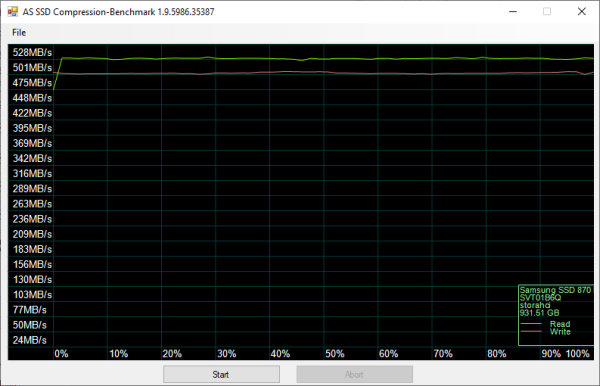
As I mentioned earlier, the 870 EVO uses Samsung's MKX controller chip. Looking at the screenshot above, you can see that it performs equally well with both incompressible (0%) and compressible (100%) data.
CrystalDiskMark 7.0.0:
First, I ran a few quick tests using CrystalDiskMark. This benchmark measures the performance of a storage device by testing its sequential and random read and write speeds. For this test, we're using the peak and real world profiles.

According to Samsung, the 1TB version of the 870 EVO is capable of reading at 560 MB/s and writing at 530 MB/s. As you can see, the drive had no problems reaching these speeds in CrystalDiskMark's sequential read and write tests.

As you'd expect, the 870 EVO wasn't as fast when tested with the "real world" profile which uses a single thread and a much lower queue depth. Nevertheless, it was still able to read and write at more than 523 MB/s.
HD Tach RW 3.0.4.0:
Next, I used HD Tach to test the 870 EVO's read, write and burst speeds as well as its seek times and CPU usage.
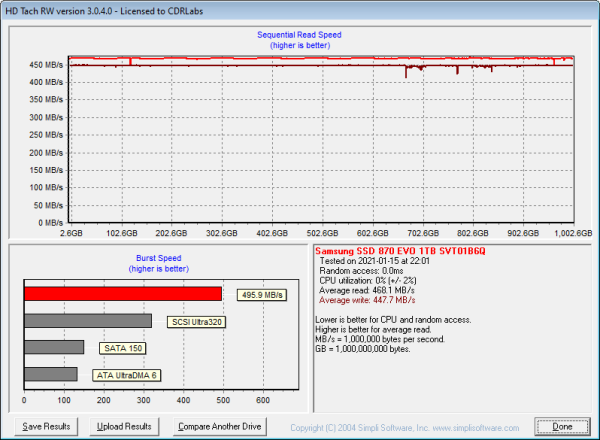
Looking at the screenshot above, you can see that the 870 EVO had average read and write speeds of 468.1 MB/s and 447.7 MB/s respectively, as well as a burst speed of 495.9 MB/s.
ATTO Disk Benchmark 4.01:
I also used ATTO Disk Benchmark to test the 870 EVO's sequential read and write speeds. The tests are run using blocks ranging in size from 512B to 64 MB and the total length set to 256MB.
When tested with ATTO, the 870 EVO's read speeds topped out at about 538 MB/s and its write speeds at 512 MB/s.
AS SSD:
AS SSD is a benchmark designed specifically for solid state drives. The application contains five synthetic tests which are used to determine the sequential and random read and write performance of a drive.
AS SSD also includes a copy benchmark. This test copies an ISO (two large files), program (many small files) and game (small and large files), returning the speed and duration of each.
HD Tune Pro 5.75:
Next, I ran a series of tests using HD Tune Pro. This hard disk utility measures a drive's performance by testing its sequential read and write speeds as well as its access time, burst rate and CPU usage. For this review, I'm also going to use it to benchmark the 870 EVO's random read and write speeds, random access times and the number of operations per second.
The 870 EVO performed relatively well when benchmarked with HD Tune. The drive had average read and write speeds of 522.4 MB/s and 499.0 MB/s, respectively.
When reading 4KB blocks, the 870 EVO reached 25,140 IOPS and had an average speed of 98.206 MB/s. The drive was slightly faster when writing, reaching 26,791 IOPS with an average speed of 104.655 MB/s.
Anvil's Storage Utilities:
Anvil's Storage Utilities is another benchmark designed with SSDs in mind. The standard storage benchmark measures a drive's performance by testing its transfer speeds, access times and IOPS.
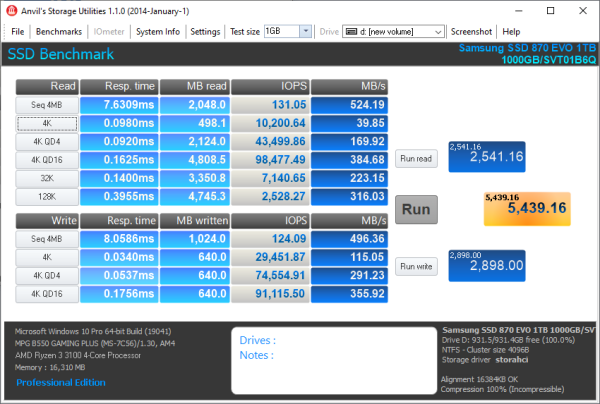
Iometer:
Lastly, I ran a series of tests using Iometer. This tool can be configured to benchmark a number of things. In this case, I used it to measure the 870 EVO's read and write speeds and the number of operations per second. The tests were run using random bytes and a queue depth of 3.
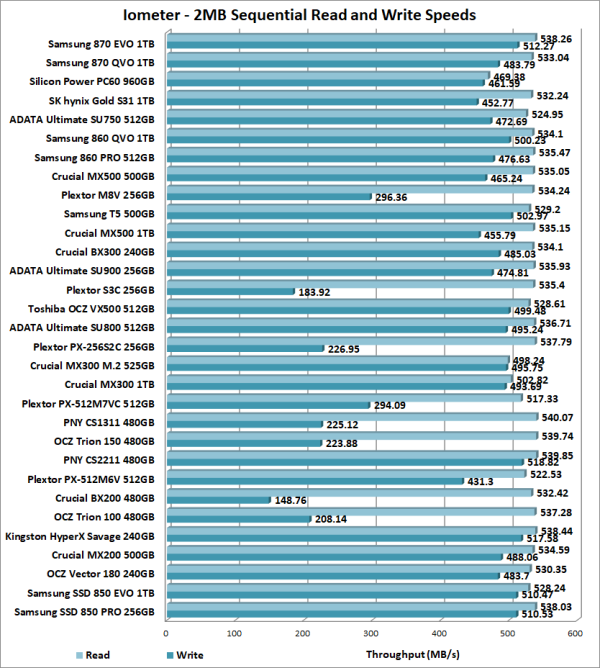
The 870 EVO's performance was very similar to what we saw in our other tests. The drive was able to read at 538.26 MB/s and write at 512.27 MB/s.
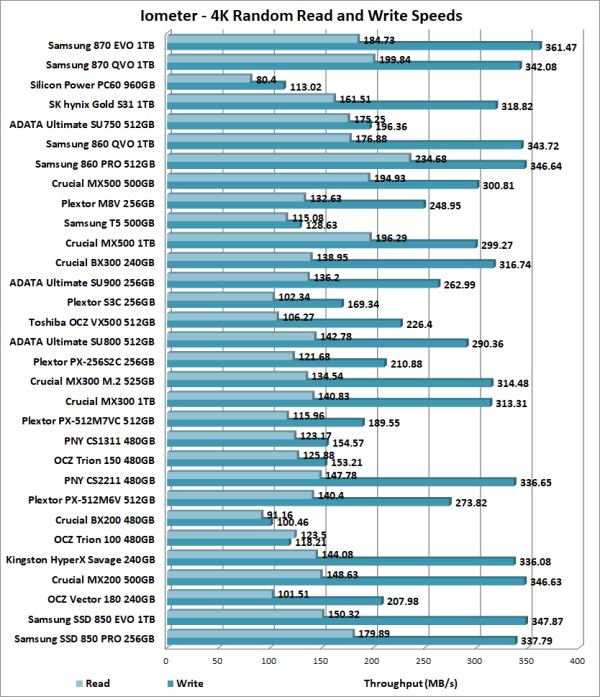
The 870 EVO also performed very well when doing random reads and writes. In our tests, the drive was able to read at 184.73 MB/s and write at an impressive 361.47 MB/s.
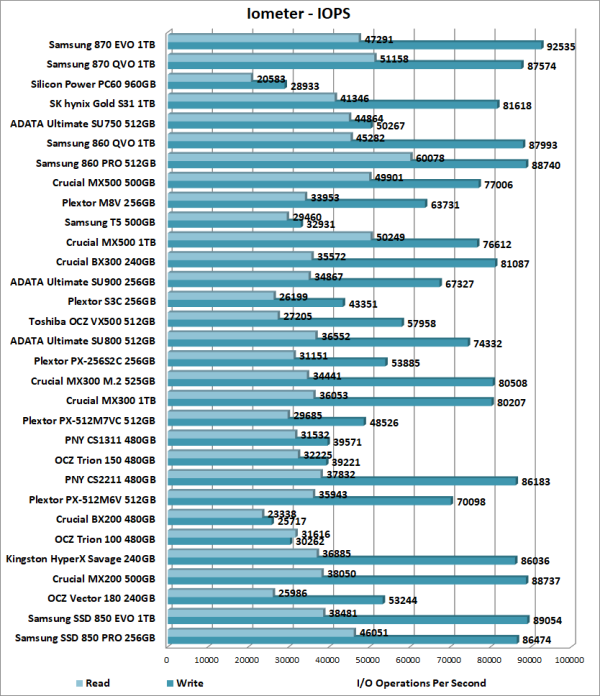
According to Samsung, the 870 EVO is capable of 98,000 IOPS when reading and 88,000 IOPS when writing 4K blocks. In our tests, the drive reached 47,291 random read IOPS and 92,535 random write IOPS. Increasing the queue depth had little impact on the 870 EVO's random write performance. However, with four threads and the queue depth set to 32, the drive was able to reach 99,348 random read IOPS.
Vantage PCMark 8 - Storage Test:
PCMark 8 is a complete benchmark for Windows. It includes five benchmark tests, each designed around a specific scenario. The storage benchmark measures drive performance using real-world traces recorded from Adobe Creative Suite, Microsoft Office and a selection of popular games.
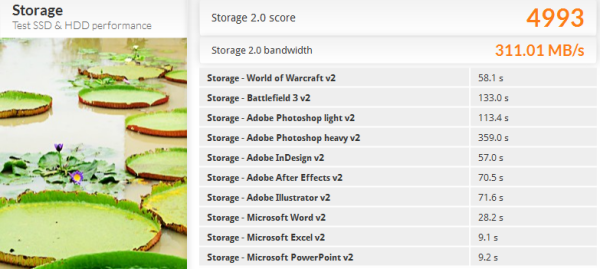
PCMark 8 also includes a consistency test which measures the performance consistency and degradation tendency of a storage system. The test reports the performance level at the start, the degraded steady-state and the recovered state as well as the number of iterations required to reach them. For this test, we are focusing on the Adobe Photoshop (Heavy) trace and will look at both the bandwidth and latency of the drive
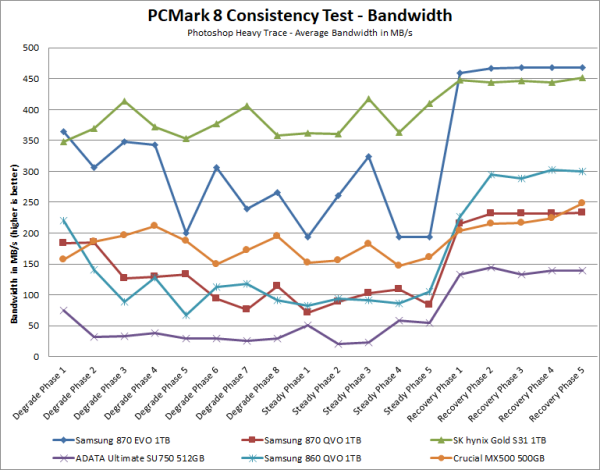
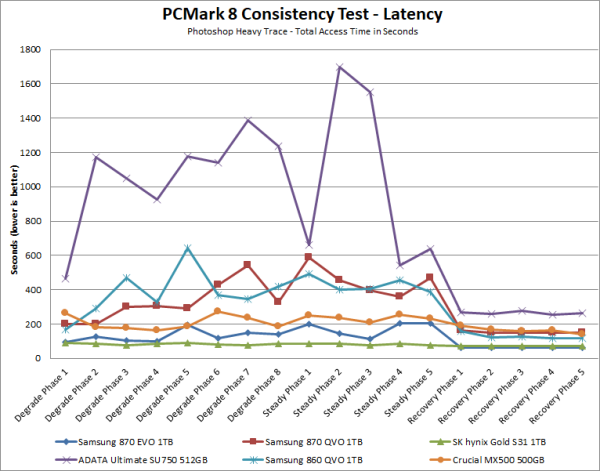
The 870 EVO did fairly well throughout PCMark's consistency test. While not as fast as the SK hynix Gold S31, it performed better than the Samsung 870 QVO and Crucial MX500 throughout the degradation and steady state phases. The 870 EVO's performance also increased during the recovery phase, topping out at about 468 MB/s.
PCMark 10 - Full System Drive Benchmark:
PCMark 10's Full System Drive Benchmark uses a wide-ranging set of real-world traces from popular applications and common tasks to fully test the performance of the fastest modern drives. This benchmark produces an overall score as a measure of drive performance. Comparing devices is as simple as comparing scores. The tests also measure and report the bandwidth and average access time performance for the drive.
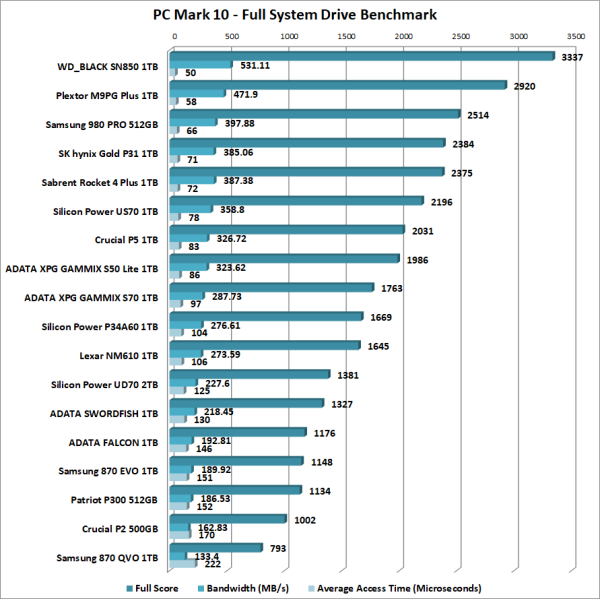
TRIM Performance:
While SSDs offer many benefits, there are some downsides to using flash memory. One of the biggest issues people run into is performance degradation. Over time, an SSD will run out of fresh blocks and will have to write over data the file system has marked as deleted. This procedure is very complicated and can slow an SSD's write speeds considerably.
To fix this problem, most manufacturers have added TRIM support to their SSDs. The TRIM command allows an operating system, such as Windows 7, to tell an SSD which data blocks are no longer in use. Using this information, the drive pro-actively erases these blocks and adds them to the free block pool.

To test the 870 EVO's TRIM function, I first put the drive in a "dirty" state. I used Iometer to fill the entire drive and then ran a random write test for 30 minutes. This had little impact on the 870 EVO's read speed. However, its average writing speed dropped to a mere 65.4 MB/s.
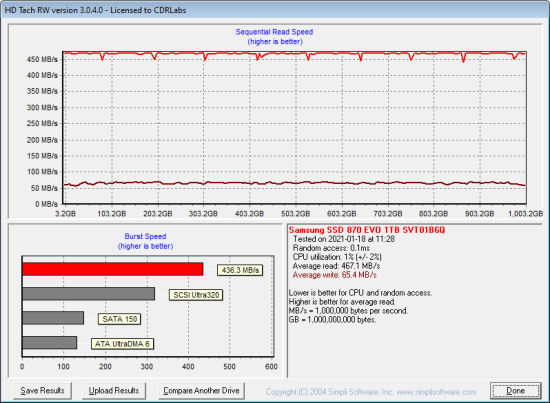
Samsung 870 EVO - Dirty
To see how well the 870 EVO could recover, I let the computer sit for about 30 minutes and then reran the test. The drive wasn't able to reach the factory fresh performance shown in our earlier tests. However, its average write speed jumped up to 424.9 MB/s.

Samsung 870 EVO - After Trim
Lastly, I used Parted Magic to perform a secure erase on the 870 EVO. With the drive wiped clean, it had average read and write speeds of 467.7 MB/s and 432.5 MB/s, respectively.
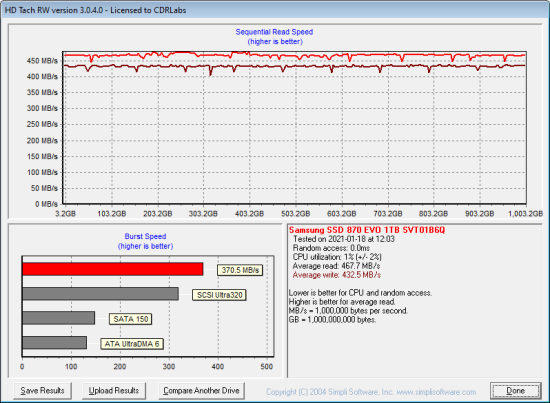
Samsung 870 EVO - Secure Erase
Final Thoughts:
Samsung's EVO series SSDs are known for delivering performance, reliability and storage capacity at a reasonable price and the 870 EVO is no exception. Designed and built entirely in-house, this new 2.5-inch SATA SSD is powered by the same MKX "Metis" controller found in the 870 QVO and is available with up to 4TB of Samsung's latest 3-bit MLC V-NAND flash. Combine this with a large DRAM cache and the company's Intelligent TurboWrite technology and you have one of the better performing SATA SSDs on the market today. In our tests, the 1TB version of the 870 EVO was able to read at speeds as high as 564 MB/s and write at speeds in excess of 530 MB/s. The drive also did very well in our random write tests, producing more than 92,000 IOPS at low queue depths.
Of course, speed and capacity aren't the only things the 870 EVO has to offer. Along with support for Samsung's Intelligent TurboWrite technology, the drive features AES 256-bit full disk encryption and is compliant with both the TCG Opal 2.0 and IEEE 1667 specifications. The 870 EVO also works with Samsung's Magician software and is covered by a 5 year warranty with an endurance rating of up to 2,400 terabytes written (TBW) for the 4TB model.
The 870 EVO comes in 250GB, 500GB, 1TB, 2TB and 4TB capacities and will be available worldwide starting this month. Prices range from $40 up to $480 with the 1TB model reviewed here retailing for about $130.

Highs:
- Available in 250GB, 500GB, 1TB, 2TB and 4TB capacities
- Equipped with 3-bit MLC V-NAND technology
- Good sequential and random read and write speeds
- Features Intelligent TurboWrite technology
- Large DRAM cache
- Supports TRIM and garbage collection
- AES 256-bit full disk encryption
- TCG Opal 2.0 and IEEE 1667 compliant
- Includes SSD Magician software and Data Migration Tool
- Great endurance
- Reasonably priced
- 5 year warranty
Lows:
- Not as fast as NVMe SSDs
